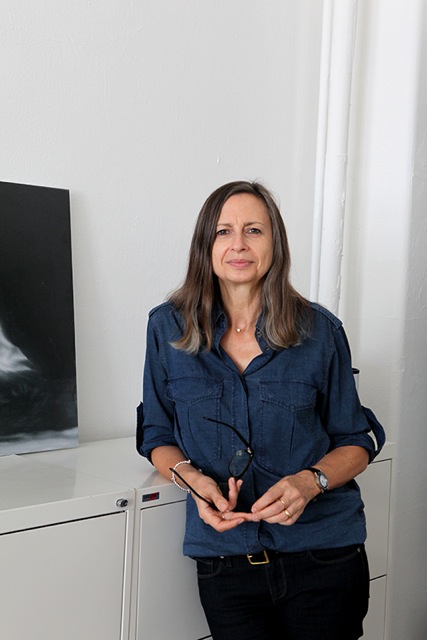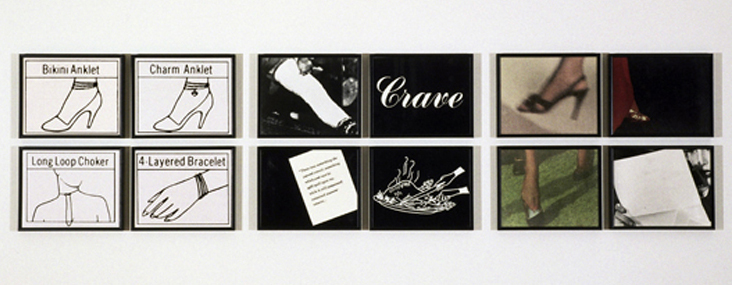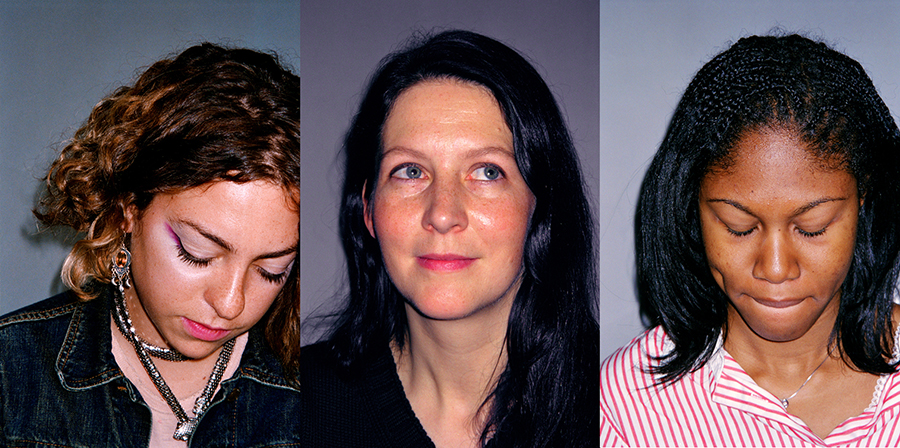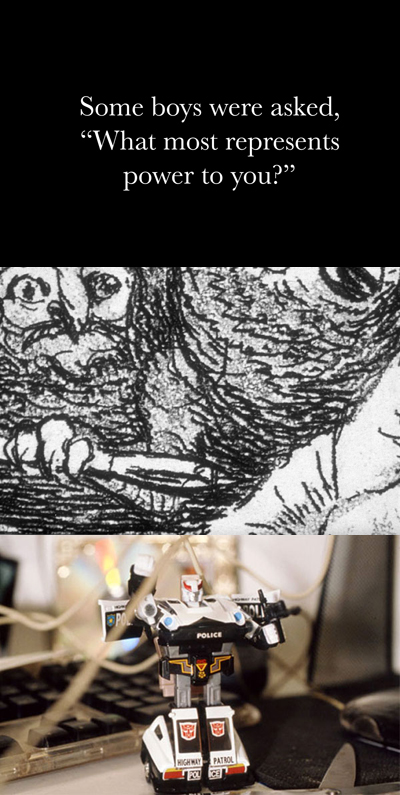CHRYSANNE:
I really enjoyed reading your interview with Hal Foster in the catalogue for your show at Secession in Vienna. One thing that popped out that was very interesting to me was the reading group you participated in with Jane Weinstock and a few others. I’d like to ask you how that informed your practice and did it change your view, because you were a young artist at that point.
SILVIA:
It completely shifted my focus. As I mentioned in that interview, after transferring from Franconia College in New Hampshire to Hunter College in New York in the mid-70s, I attended what I think turned out to be the last few meetings of Artists Meeting for Cultural Change, in the Fall of 1977. I had the sense at the time that the group was losing its cohesion, and by my third meeting or so it was suggested that we break up into reading groups. I gravitated toward the “Feminism and Psychoanalysis” reading group. I was the only artist in the group and I think there were about four or five other women in it who were, like Jane, studying film theory at NYU. I met Jane through that group. I think there were two men who joined the group, but they left after a session or two. I had studied art history, and had read some Marxist theory on my own, but at that point I wasn’t conversant with either film theory or psychoanalytic feminist theory. We read Juliet Mitchell’s Women’s Estate (1971) and Psychoanalysis and Feminism (1974), Levi-Strauss on kinship structures, and some Freud. I think we read Lacan, but I’m not sure.
Looked at from the outside, you would likely think that the group had the effect of introducing me to a new way of thinking about feminism. And it did. But almost more importantly for me, it was an introduction to the ways in which the psyche informs daily life and politics, an introduction to understanding a crucial way in which subjects are formed. The introduction to the significance of the unconscious in the social realm changed everything for me. Now, you could say that a feminist perspective is the best point of view from which to approach this anyway, building on Jacqueline Rose’s notion that feminism had to take up the task of understanding how femininity is engrained in the human subject.

Video still from After Hiroshima Mon Amour, 2008. 22 mins., video and b+w film. Courtesy of the artist.
CHRYSANNE:
Did the reading group last a long time?
SILVIA:
I think it lasted about a year. But then for about a decade I read French and British film theory, post-structuralist philosophy, the French psychoanalytic feminists, post-colonial theory, progressive approaches to anthropology. I also received an education at the conferences that took place almost weekly in New York in the early 1980s, which brought together people from all those fields, but driven largely by an art context. In fact, I would say that I reached my surfeit of conferences in that period!
SUSAN:
When I was at Cal Arts, I watched nearly every film by Jean-Marie Straub and Danièle Huillet. We did this in the context of Michael Asher’s class and so we didn’t talk about the films strictly in the terms of film theory, but one of the upshots of watching those films for me was a serious consideration of the notion of resistance as a model, something I still think about. I wonder if that was also part of your thinking?
SILVIA:
Resistance in what way?
SUSAN:
Resistance as a model for a critical practice. Not in relationship to consumerism, but informing the the kind of work one produces; how much criticality (based on a theoretical model) one is going to adopt in making work, because for me the relationship of critical theory to making work seems somewhat problematic.
SILVIA:
Why?
SUSAN:
All the theory that I learned informs my thinking but I don’t feel that there is a direct line between that understanding and the work I make. They don’t do the same thing, and I don’t really expect them to do the same thing. Now, as a more mature adult, looking back retrospectively, I would imagine that the people who were my teachers and mentors would frown upon the work I make.
SILVIA:
Oh I don’t know about that, because I think a lot of the people who wrote theory in the 1980s and 1990s were very critical of artists who they considered to be “applying” theory. So I certainly never felt that as a demand coming from the theorists.
SUSAN:
You could almost not do right, is I guess what I am saying.

If it should turn out to be true, 2014. Two video loops on adjacent screens: 00:04:17;
00:02:48. Commissioned for the exhibition “A letter always arrives at its destinations,”
curated by Sebastién Pluot for La Panacée, Montpellier, France, 2014.Views of
installation.
SILVIA:
I’ve been very, very fortunate with the critical writing on my work, but at the same time, theory is not a manual for how to make art. Historians and critics have their own disciplinary challenges in writing about artworks, but it seems to me that for spectators who see a work in person, the work shouldn’t be at its best as an illustration for a theoretical text. That said, I think it took me a while to calibrate spectatorial address.
The Straub-Huillet films were important for me at the time for their intense focus on methodology — framing, pacing, and the point of view of the camera. So if the entry of the unconscious into my early thinking about politics and art was crucial, it also became clear to me that aesthetic methodologies couldn’t be disentangled from an address to the psyche. Because I never saw art as just a vehicle for getting a message out. I don’t know if it was his own distinction, but Victor Burgin’s dictum of the late 1970s made an impression on me — that one should pay attention not just to the representation of politics, but to the politics of representation. Theory helped me to understand the structural dimensions of art works — how form creates meaning, how to understand the subtleties of spectatorial address. That persists for me today. There’s still a lot of art around that doesn’t consider the address to the spectator — even when it’s work that is universally thought of as progressive, or as a political challenge to an iniquitous status quo or historical legacy.
I came of age as an artist in a post-Duchampian period, after historical Conceptualism, but also in a post-structuralist moment when the status of authorship and authenticity in the artwork was being questioned. And to some extent that led me and others in the 1980s and 90s to a concept of creativity in which an external formula or directive is set in motion to produce an artwork, in effect, without a subjective decision-making process along the way. You could see it as a move away from conventions of composition, for example, or from a fetishized expressivity connected to the hand. That move away from the fetish of the personal in art was very important for me. It was exhilarating.
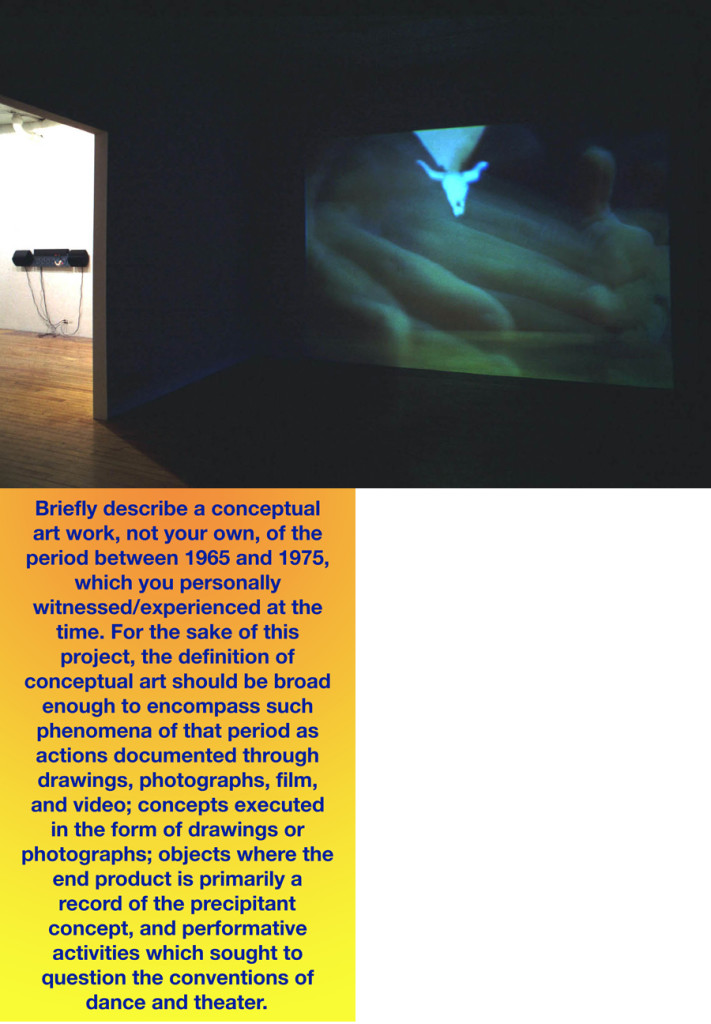
an inadequate history of conceptual art. Installation view of video room at American Fine Arts,
1999, and wall text. Photo by Takahiro Imamura.
SUSAN:
Would you say it still is?
SILVIA:
Well, I understand the ideological ramifications of that move away from hide-bound conventions, the turning topsy-turvy of the notion of the autonomous creative subject as it was understood for centuries, away from the delusion of “free choice.” I understand why I turned against those conventions, having started out as an abstract painter when I was young. But then my thinking changed when I started formulating an inadequate history of conceptual art in 1997. I started to realize that there should be some uncontrollable aspects of the work. That even though I could write out in a few sentences what I thought the work was going to be, once I set it in motion, I wasn’t just going to see that realized in a formulaic way, I wouldn’t allow the external directive to fully determine the outcome of the work.
That external directive could have driven the work to completion — to record some people talking about their personal experiences of Conceptual artworks by other artists of the historical period 1965-1975, giving the speakers very particular limits. But once I started to conduct the tapings, I thought of recording the speakers’ hands while they were speaking, extending the work from the aural to the visual, which was outside the external logic of the original directive; I also made an unexamined decision to remain silent myself.
It’s not as though the production process was ever going to turn into flow-of-consciousness (or what Joan Copjec has more rightly called “flow-of-unconsciousness”), because it was always going to be the case that I had to make some considered decisions along the way. But at the same time, I realized that I was depending on ideas that were not fully thought out ahead of time, and were perhaps beyond rational explanation.
SUSAN:
Do you think that even though you recognized that the unconscious was so important, that it actually took you a while to give it the space to drive things? In my own experience I feel that’s what happened. I don’t know exactly what one would call it; creating more room for process and unpredictable accidents in the outcome.
SILVIA:
I stopped imposing a kind of hyper-rational structure on the process.
an inadequate history of conceptual art was also a threshold project in that I was determined to make my works self-contained, meaning that a spectator could encounter the project and start to engage with it in the moment, to have the full experience of the work without feeling they needed to have information supplied by a wall label or a critical text, or any kind of explanation. I don’t think I’ve ever done a work after that which wasn’t like that.
— Excerpt from an inadequate history of conceptual art, 1999.
SUSAN:
But that’s a very significant change.
SILVIA:
Huge. There were projects I’d done before that I suppose you could say were of that ilk, like the “Model Pleasure” photo series of the 1980s, but the works I did in the 90s, in particular, depended quite a lot on the paratextual elements that would frame the work — the invitation and wall label, the press release, the critical text, the catalogue layout, a resulting interview. Starting with an inadequate history, through to my most recent project, If it should turn out to be true, I’ve aimed for the spectator to need no more than an experience of the work to engage with it fully.
CHRYSANNE:
With your works such as an inadequate history of conceptual art, Like Looking Away, and Proximity to Power, there’s an intriguing aspect of memory, coupled with your interactions with diverse groups of people and their stories or their recollections. What really shocked me with an inadequate history of conceptual art is that the people who have the memories, a lot of times they were very, almost emotional memories of what they considered a conceptual art moment, which I hadn’t expected. I expected a more distanced intellectual recollection but for some of them they seemed to have had a breakthrough.
SILVIA:
And it’s so consistent; so many of them spoke that way.
CHRYSANNE:
I was wondering if that was a surprise to you, or how you would see that in psychoanalytic terms, the aspect of how our memory serves us, and how that might influence your work.
SILVIA:
The work has been written about that way quite a lot, in terms of memory being overdetermined, faulty, partial — the representational and political consequences of that. Rosalyn Deutsche, for example, has written about the ethics of inadequacy in the work. I think that’s why the work has also been written about in term of challenging historiographic conventions. Facts exist, but even the ways in which facts are put together, or left out, can change perceptions. Memory is a kind of storytelling, more than anything else.
I was very surprised by the quality of the accounts. They turned out to be not only much more compelling retellings than I thought they would be, but they’re also more, I don’t know, heartfelt. An unexpectedly interesting aspect of making the work was that I went to most of the 22 artists’ studios to tape them. I think that artists often feel somewhat vulnerable having a visitor in their studio. And I started to feel during the process that the somewhat confessional quality of their retellings had something to do with my role as a silent listener during the process. Mignon Nixon was the first to point out to me after the work was finished that in a sense I occupied the equivalent of the psychoanalyst’s position in the production process — silent and listening.
CHRYSANNE:
That’s very interesting.
SILVIA:
Mignon also pointed out to me that the register of my silence in the finished work — which she saw as an authorial register — as well as the anonymity of the speakers and their recounting of memories in the face of my silence, created an experience for the spectator that mirrored the transference between analyst and analysand, with all the challenging of authority that can be inscribed in the transferential dynamic. In her brilliant text “She-Fox” she locates the transferential dynamic in society at large, and by definition then also in the spectatorial experience. By challenging Freud’s placement of the feminine outside the inherent ambivalence of transference, also as a social construct, her text creates a space for feminine subjectivity in culture, and for a rethinking of post-structuralist ideas of authorship.
Mignon’s reading of an inadequate history gave a retrospective form to what I had not theorized as I was making the work. And by the way, you could say that’s how psychoanalysis also works — something that took place in the past is recounted in the present and given meaning in the space of the psychoanalytic setting that is no less authentic or impactful than how it was first experienced.
Another interesting aspect of memory in the project is that so many of the participants recount a memory of a performative work, the kind of work that involves movement, sound, sometimes narrative — there’s experiential engagement.
SUSAN:
It’s really a dreamscape, in a way.
video ©2014 by MOMMY
SILVIA:
But the retrospective exhibitions and catalogues that prompted the project included very little of that work, maybe because the performative is hard to re-exhibit. What the artists in an inadequate history seem to be conveying is that when there’s more than one sense involved in a witnessed event, it leaves a particularly strong imprint on the memory. That’s quite telling, I think.
CHRYSANNE:
Right.
SUSAN:
I had an odd experience of that piece, which may be way out there. I began by taking the description of it quite literally but very early on in watching it, I felt that the hands were out of sync with the voice, even before I saw the first shift that makes it more obvious that this is so. As a result of that, I was thinking about the way that out of sync sound can function as a critique of information, and I started to speculate that the whole piece was scripted. I was never sure from that point on, whether that was the case or not.
SILVIA:
You watched the teaching and web version of that project, where the sound and image are collapsed, but in the real installation, the sound and video are in separate rooms. But I think you might still end up with the sense that it was scripted.
SUSAN:
I really had no idea. But I thought you had written the whole thing.
SILVIA:
No one’s ever said that, but I suppose I could have. That would have been the ultimate post-modern ruse, right?
SUSAN:
Well, sure! I really didn’t know, until you were describing it now. It just got my head going to this whole other place.
SILVIA:
That’s interesting. It may have to do with the fact that they’re recounting what they believe to be true, but of course it could be fiction.
SUSAN:
One way to look at it is that this is a form of memory that lingers, and becomes an encrusted nugget that they remember. Memories retold, especially more than once, can take on the characteristics of a scripted narrative.
SILVIA:
It could also convey that quality because the speakers, who were not edited at all, were so remarkably eloquent .
CHRYSANNE:
We see Marina Abramaovic doing the re-performances of hers and other artists such as Joseph Beuys from similar time; not that this is connected.
SILVIA:
It’s not disconnected, actually. I surprised myself by liking those re-performances, in part because they’re so obviously the re-presentation of the historical. But one difference is that the artists in an inadequate history got a lot of facts wrong.
SUSAN:
One would imagine that would be the case.
SILVIA:
And there was no need, even in subsequent publications, to correct those mistakes. I think it was that set of limits — anonymity, not correcting mistakes, not showing the participating artists or referenced works, asking participants not to refresh their memories before tapings — that makes the work very different from, for example, the extremely interesting Anarchism without Adjectives D’Arcangelo exhibition, curated by Sébastien Pluot and Dean Inkster at Artists Space (2011). Because although both works are comprised of what one could call “oral histories” and missing protagonists, in the D’Arcangelo project there are no limits set other than the fact that the whole exhibition takes the form of video recordings of people talking about D’Arcangelo and his work, and video views of his archive. For me, it’s the limits in an inadequate history that are the crux of the work. What isn’t permitted to be said is almost more important that what is.

Proximity to Power, American Style, 2003/2004. 91 slides, 2 projectors, continuous
projection,audio loop, 37:00. Installation view, Hammer Museum, 2014.
CHRYSANNE:
With Proximity to Power, did you impose another set of limits on the participants? Or did they impose them on you?
SILVIA:
No, that wasn’t a methodological use of anonymity, it was more to be able to get the cooperation of the interviewees. an inadequate history uses anonymity in part to play with the spectator’s expectations around the speakers’ status; in Proximity to Power the use of anonymity was just about getting insider info. I protected anonymity to such a degree that actors re-recorded the transcribed tapings so as not to reveal voices. And I had trouble, a lot of trouble talking people into talking to me. The politician in the work — I mean, I had to beg that guy. The finance guy, I had to beg. The museum person — I didn’t have to beg him, but I feel that if I ever revealed his name, it would not be good for him.
CHRYSANNE:
His responses were very interesting.
SILVIA:
It’s a very lucid and articulate account of a museum curator’s experiences of dealing with the very powerful and wealthy men, the donors and trustees.
— Excerpt of audio from Proximity to Power, American Style, 2003/2004. 91 images, 2 projectors, continuous projection,audio loop, 37:00.
CHRYSANNE:
And their expectations; how have you found that people responded to that piece?
SILVIA:
It was recently reinstalled at the Hammer, but I didn’t go out there. There are works about which I’ve been able to ascertain a reaction, whether from the critical writings on the works or from interacting with students when I’m invited into classrooms, or when students write on my work, but Proximity to Power is not one of them. I think it’s taught less than an inadequate history or the Meinhof video because it’s a double-screen image-projection with audio. There’s a book that documents it fully, which is great to have, but it’s really a work that has to be experienced in person. I myself was quite surprised by a few things when I saw it at full scale, having worked on it at a smaller scale. At full scale, the Goya details of The Dream/Sleep of Reason Produces Monsters, abstracted through enlargement, are more distracting from the audio than the boys’ images of power. I anticipated that it would be the reverse.
Spectatorial experience is many things. It’s obviously sensory, and I think artists have to take that into account. But when conceiving a project I’m also trying to project the spectator’s relationship to the discursive and material address of the work. What kind of spectator is the project creating? Is the combination of discourse and structure and medium going to create a defended spectator who perceives themselves as outside the work, as if the address is always to someone else? Or does the work produce someone who might take in what is being presented even, for example, while feeling discomfort? Might the work create a sponge-like spectator, or someone who might use the work as an interpretive “filter” for a while? Psychical foreclosing on the part of the spectator is something I’m always trying to avoid.
CHRYSANNE:
Do you think that your early experience working at The Institute for Architecture and Urban Studies informed your thoughts on the viewer as a participant, in how you install your works?
SILVIA:
Hal asked me a similar question. I’ve overlapped quite a lot into the architecture world — eight years at the Institute working on exhibitions and editing catalogues, then over a decade of collaborating with architects and teaching history/theory courses in architecture programs on the overlap of art and architecture, and years of editing architecture books. For me, it was primarily a way of making a living. And I tend to think that my experience of architectural design and history/theory didn’t have have an impact on the way I work. But I do work somewhat spatially, so maybe I’m wrong. I tend to blank on that question!
CHRYSANNE:
I was just curious.
SILVIA:
I think what I said to Hal in that interview still stands. Architecture and art are such different discourses and practices. I used to argue with my husband, Kenneth Frampton, who’s an architectural historian, a lot about this in the 1980s, when I saw the fields as more related. But in fact, having had direct architectural experience, I started to agree with him more. While I can see the virtues of arguing for the fragmentation of spectatorial experience in art — which is one reason I often separate sound and image — I can see why one would have different disciplinary expectations of architecture. Creating stability is not a retrograde aim for architecture. I’m not talking about returning to Classicism in architecture; far from it. Architecture has to deal with the modern and the contemporary as much as art does. But the ideological aims are very different.
And I would say that my work has actually become less spatial in the last fifteen years. I moved to the single-screen work with an inadequate history in order to gain more control over production, to be less dependent on commissions.
SUSAN:
I wanted to touch on the piece you did on Ulrike Meinhof — a few howls again?, because I think it is incredibly moving, but also because I think it is very apropos of the moment. There is a quote in the work that states: “Have you noticed that some types of violence make people feel secure.”
SILVIA:
You’ve pulled out possibly the only line in the whole work that I wrote!
SUSAN:
Is that right? Well, it is really well observed. The thing that’s so amazing about that work is how prescient it is, given what is happening in the world right now. It’s even more ironic, given the marks on her neck, and thinking about those poor people who have recently had their heads cut off; snuff films for the 21st century. We’re confronted with the question of what kind of violence is acceptable, what kind of violence makes us indignant, whose agenda is behind that violence, and what it is trying to address. Ulrike Meinhof seems like the poster child for these questions.
SILVIA:
I feel overwhelmed by the rhetoric of violence these days. For example, Obama’s recent U.N. speech justifying aerial attacks, which identifies the historically created upheaval in Iraq and Syria as an “evil” that cannot be appealed to with reason. I heard an academic on the radio — a lone public scholar’s voice — specifically challenging the international legality of the planned military action. He said in regards to international law that most governments think that international law really doesn’t matter…until it matters. That is, until someone’s bombing you!
When I started the Meinhof project, I was looking to do a project about violence. I thought of the Baader-Meinhof, Red Army Faction group because I was thinking about what happens to people when they feel that their voices are not being heard by those in power. But when I started to do the research I realized right away that Meinhof was head and shoulders above the other members of the group. I found her very different from the other two well-known Baader Meinhof figures. Ironically, I think she was less involved in acting out her personal history than the other well-known figures were, although her actions have always been publicly explained by her personal traumas. When I started to read her pre-underground journalism, I couldn’t get over her political prescience. Political prescience is a very important quality for me, also with regard to Rosa Luxemburg, on whom I’ve been working. In doing that research on Luxemburg, I read Hannah Arendt’s brilliant little review of an early biography of Luxemburg, and I found a similar kind of political intelligence and prescience in Arendt. All three read the structure of a political period brilliantly, and that allows them to interpret historical terrain with enormous acumen.
CHRYSANNE:
How long have you been working on the Luxemburg piece?
SILVIA:
Too long! About two years. Originally, after Meinhof, I thought I was going to resuscitate Vladimir Mayakovsky, to revive a figure who — and by the way, Luxemburg is a little like that also — lived though some of the best and the worst periods of socialist transformation and still remained committed to the idea of socialist or left possibility. I wanted to work against the western, mostly American glorification of the fall of socialism. I wanted to complicate that scenario. But Mayakovsky,while remarkable in his commitment to Russian revolutionary values and his ethical political stances, wasn’t the right figure for me. I couldn’t deal with his self-romanticizing and the cultural heroicizing of him. Then I read a Jacqueline Rose review of a new translation of Luxemburg’s letters, and I thought, this is my figure.
CHRYSANNE:
What did you see in both of those figures’ writings or letters that was a sort of “ah ha” moment, that you hadn’t expected?
SILVIA:
Luxemburg was objectively a remarkable figure — her political engagement spanned three revolutionary moments in three different countries, she was imprisoned about six times, and was a solitary voice in condemning the left’s support of World War I. Also, all three women have the quality of not belonging, of not identifying with dominant power of any kind, which I find fascinating. One thing I noticed in Arendt’s review of Luxemburg’s bio was Arendt’s identification with her uprootedness. Julia Kristeva refers to Arendt as “the girl from abroad.” Luxemburg was also that.
SUSAN:
Do you think that’s a coincidence? That women, per se, would have that?
SILVIA:
It’s probably not a coincidence. It’s not that you couldn’t find men like that. But the independence of thought that these three women had was probably derived in part from their social or institutional marginality as women. What appeals to me most about these three women isn’t actually their intellectual and social gutsiness — and I’m not whitewashing Meinhof’s involvement with the deaths for which the Baader Meinhof group was responsible — but their capacity to face very, very disturbing structural truths head on. I think their prescience was directly related to their capacity to face realities that others were defended against or identified with.
— If it should turn out to be true. Excerpt of one of two videos.
SILVIA:
I suppose the only overtly feminist of the three was Meinhof. Her film Bambule (1970) is a clear indication that she saw the status of women as a political condition that urgently needed to be addressed. Luxemburg and Arendt both largely disdained feminism as a political endeavor.
CHRYSANNE:
Do you think that was generational?
SILVIA:
No, because there were women around the two of them who publicly identified with feminist discourses. It’s very complex, particularly in regards to Luxemburg, who was urged to write feminist texts for the party papers and complied, but didn’t actually feel that feminism should be singled out as a particular struggle, in the way that as a Jew she didn’t feel that the historical oppression of Jews should be privileged over the suffering of other groups- the colonized, for example. But it was very clear that all three women paid a price for assuming strong public voices as women. And whatever kept them up at night then, and whatever in the present is making them turn over in their graves — for surely they are! — maybe that’s what I’m drawing on to jolt the spectator.

